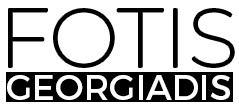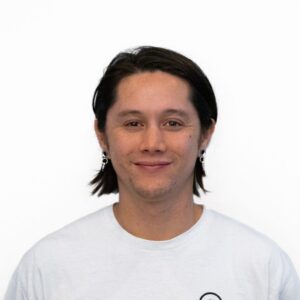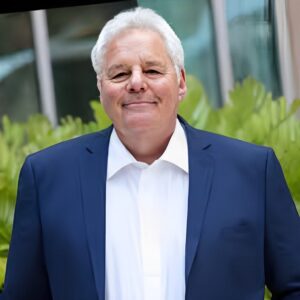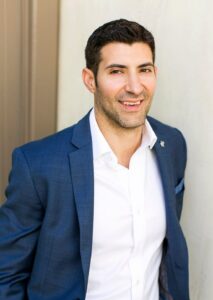Meet The Disruptors: Dr Nathan Price Of Thorne HealthTech On The Five Things You Need to Shake Up Your Industry
An Interview with Fotis Georgiadis
Demonstrate your commitment, your credibility, your success. It’s not enough to talk about it, you have to actively show it, back it up, and do it — consistently. You can’t build a reputation on what you plan to do; you build it on what you’ve done, on what can be tested and proven.
As a part of our series about business leaders who are shaking things up in their industry, I had the pleasure of interviewing Dr. Nathan Price.
Dr. Nathan Price is the Chief Scientific Officer of Thorne HealthTech (NASDAQ: THRN), a science-driven wellness company that utilizes testing, data, and artificial intelligence models to deliver personalized solutions to consumers, health professionals, and corporations. Previously, he was CEO of Onegevity, a platform for precision health and medicine, which merged with Thorne in 2021, and serves as its A.I. and health intelligence engine. Dr. Price’s academic career included serving as Professor and Associate Director of the Institute for Systems Biology and an affiliate faculty member across the bioengineering, computer science, and molecular and cellular biology departments at the University of Washington. His credentials include being recognized as one of 10 Emerging Leaders in Health and Medicine by the National Academy of Medicine in 2019, and receiving a Catalyst Award in Healthy Longevity from the National Academy of Medicine in 2020. In 2021, Dr. Price was appointed to the Board on Life Sciences for the National Academies of Sciences, Engineering, and Medicine.
Thank you so much for doing this with us! Before we dig in, our readers would like to get to know you a bit more. Can you tell us a bit about your “backstory”? What led you to this particular career path?
I’ve always loved science. From a very early age, I have been interested in learning more about the world. Curiosity is mainly what led me here: a desire to connect the dots between different areas, to contextualize what’s new, to discover what’s next.
Pursuing a PhD in Bioengineering put me on the path to health tech. Initially, this was about building computational models of biochemistry in the body, answering questions like how do you turn the food you eat into energy, into yourself? Then, as a post-doc at the Institute for Systems Biology, and continuing as an assistant professor at the University of Illinois at Urbana-Champaign, I became interested in Systems Medicine, which is about trying to understand disease. We did a lot of work on cancers and Alzheimer’s, and it got me thinking about the idea of detection and prevention versus treatment.
As a society, we wait until it’s way too late to deal with disease. Even when someone proactively goes to their doctor with early warning signals, a typical response is, come back after you’ve had this terrible symptom, and at that point, you’ll get a drug to help you manage that symptom. We have all had, or know of, experiences like this. I believe we can do much better, and it’s vital that we move forward from disease-focused health care.
For me, that started with a project I did jointly with Dr. Leroy Hood, who has a very notable back story. Lee is a pioneer of systems biology, the recipient of a National Medal of Science from President Obama, and the inventor of several notable scientific instruments, including the first automated DNA sequencer — which made the Human Genome Project possible. Lee and I got together and led a project called the Pioneer 100 Wellness Project, in which we looked for individuals who wanted to go through a data-intensive journey of understanding health and wellness. Over the next few years, we ended up pulling together the largest multiomic data set that had been prepared for people at that stage, mapping out what happens before disease starts and publishing a bunch of scientific papers on our findings. That is how I became interested in what can be done to stop disease, to optimize wellness, and to explore ways in which science and technology can drive better outcomes so we can take more control of our health.
And that is what got me to where I am today. Taking what we’ve learned from science, and translating it out to society to drive the future of personal health is at the core of my mission at Thorne HealthTech.
Can you tell our readers what it is about the work you’re doing that’s disruptive?
We are working toward fundamentally transforming the way health care is practiced and charting the next frontier toward a wellness-centric paradigm, moving from chronic disease management to prevention and healthy longevity.
Here’s why this is disruptive. The foundations of modern medicine in the United States were established in the early 20th century with the Flexner Report, which was put together in a world in which people were, by and large, dying of infectious diseases. It set up the entire “find it, fix it” mentality. With the tools available at the time, it made sense to wait until you saw symptoms before you could take action to address the problem. That path to finding a pathogen, identifying the bacteria and killing it, got bolted into a new paradigm — find the target and drug it — being applied across the board. Although it has certainly been useful, this paradigm hasn’t worked that well when it came to eliminating chronic disease. We have certainly not relegated to the dustbin of history chronic diseases like we have some of the great infectious disease killers of the past.
New technologies, new factors we can make measurements on, and new intelligence we can bring to bear through modern computational approaches are now setting us up to think in a radically different way about how we view our health. It sets us up to be much more proactive. What can I do to optimize my wellness today? How can I avoid catastrophic outcomes as I go along? How can I extend my health span and enjoy more years of health?
Through testing, through using artificial intelligence models offering personalized insights and data, and by implementing innovative solutions across both direct-to-consumer and business-to-business channels, Thorne HealthTech is leading the preventative health and wellness market and empowering individuals to live healthier longer.
Can you share a story about the funniest mistake you made when you were first starting? Can you tell us what lesson you learned from that?
I remember starting out in grad school and being really excited about some of the bioengineering research work I was doing. I started to write a discussion on the first paper I wrote, deciding on a very in-depth approach, where I kept going on and on about the implications, expanding the scope and the ambition at every turn. I turned it in to my advisor, Dr. Bernhard Palsson, and his response was simple: “Have I ever talked to you about how to write a discussion?” followed by promptly sitting me down and circling one sentence — “That one’s nice, keep it.” As far as the rest of the discussion, it was back to the drawing board. It taught me about scientific rigor, about understanding and following a process, before experimenting to push the boundaries of what has been done before or what is possible. It also reinforced the importance of being grounded in scientific research but very deliberate and precise about getting to the core of what matters.
We all need a little help along the journey. Who have been some of your mentors? Can you share a story about how they made an impact?
The mentor who has had the biggest impact on my life is Lee Hood. Lee was always a hero of mine in science — a remarkable thinker whose personal story fascinated me. He is one of the fathers of personalized medicine — he won the Lasker Prize and the National Medal of Science for his work in molecular immunology, and he is credited with launching a new era in science. What I really love about Lee is how fearless he is pursuing new paradigms and pressing forward with determined optimism. He has this incredible history of not only building groundbreaking science, but then translating it into the world through the companies he has founded. I became really interested in learning from him, so I signed up to do a post-doctorate. I even deferred a faculty job I already had to go work with him and learn about systems medicine. It’s a true honor and privilege to learn from Lee, and it’s had a transformative effect on the direction I’ve taken in science, in my career. Years later, he recruited me back to ISB and we ended up co-founding Arivale (an early scientific wellness company) and ultimately combining our research groups together into a joint enterprise, which is what I was doing before I joined Thorne. I still stay connected with our lab and ISB.
In today’s parlance, being disruptive is usually a positive adjective. But is disrupting always good? When do we say the converse, that a system or structure has ‘withstood the test of time’? Can you articulate to our readers when disrupting an industry is positive, and when disrupting an industry is ‘not so positive’? Can you share some examples of what you mean?
Disrupting is positive when it makes something new possible that benefits people in general, especially when it prolongs or saves lives. It’s important to acknowledge there is utility in established methods and models, in how things have been done in the past, or else we wouldn’t have used them. I think whenever you aim to disrupt, you must understand very clearly what the reasons are requiring change, and what it is you’re pushing against. If we look at health care, there are many reasons it was set up the way it is, and there is a lot that should be looked at very carefully. You need to articulate the tradeoffs and the positives of what you’re bringing to the industry, know what you’re trying to move to, and identify the motivators — the human problems that can be solved through new technology — and to imagine the implications, the new outcomes technology makes possible.
Can you share five of the best words of advice you’ve gotten along your journey? Please give a story or example for each.
- One of the best words of advice I’ve received is unleashing the power of determined optimism. As a leader — in any industry — your role is to bring people together in service of a larger vision, a higher goal, and it often comes with the responsibility of forging a new path. There is no template. You have to put in the hard work, fearlessly and relentlessly, bring a positive mindset while being mindful of what it will take to overcome challenges, and empower others to turn optimism into meaningful progress.
- Demonstrate your commitment, your credibility, your success. It’s not enough to talk about it, you have to actively show it, back it up, and do it — consistently. You can’t build a reputation on what you plan to do; you build it on what you’ve done, on what can be tested and proven.
- Prioritize empathy and put people first. It’s remarkable what you can achieve when you come from a place of truly understanding the needs and challenges of others. Technology enables new solutions and new possibilities, but first you must understand people’s needs.
- Keep testing, experimenting, iterating, refining. Get as much feedback as you can and from a variety of sources. Don’t be afraid to keep going until the product, the idea, or whatever it is you’re working on, is in the best form possible within the time constraints necessary for moving ahead.
- To truly innovate, you must be willing to transform at the core. I love the idea of pursuing the “adjacent possible” to borrow a phrase from Stuart Kauffman — what only just now became possible because of pieces that exist now that didn’t exist before. This is a subtle but really powerful concept. Lots of things are possible — but when? And what have the things that were invented this year, this month, today, newly brought into the adjacent possible? I always have a wish list of what I want to see brought into being, and with my team we scan all the time for that next piece that suddenly makes a dream worth pursing now. When you stay open to new possibilities, when you are curious about new ideas and perspectives and allow them to impact previously held beliefs, that’s when the real breakthroughs happen.
We are sure you aren’t done. How are you going to shake things up next?
I’m excited to continue learning and to join forces with others across health care and society so we help individuals live a healthier life longer. This will include using science and technology to not only solve, but also to prevent problems, and do that by tapping into the power of genomics, into advances around understanding the molecular basis of disease, and refining what precision and personalized health means. These are some of the areas I’m looking forward to exploring.
Do you have a book, podcast, or talk that’s had a deep impact on your thinking? Can you share a story with us? Can you explain why it was so resonant with you?
Lifespan by David Sinclair is a transformation book that is compelling people to think more about aging and what might be possible now and in the not-so-distant future. Another book that has a very meaningful impact in my life is Flow: The Psychology of Optimal Experience by Mihaly Csikszentmihalyi, which is a remarkable combination of deep insight and practical guidance to achieving the best out of your life. And The Drive by Dr. Peter Attia is a fantastic podcast, which I think gives people a massive amount of medical insight into how they can improve their health span with lots of practical advice and deep science discussions to back it up.
Can you please give us your favorite “Life Lesson Quote”? Can you share how that was relevant to you in your life?
One of my favorite life lessons is about intention: set out to do what you love most and see where it leads. Your impact, your ability to make a difference doesn’t necessarily come from setting out to change the world. It comes from focusing on what you love and think is meaningful, and then practicing it to the best of your ability. I think this resonated with me in my career because I have always enjoyed the process of taking on a challenge — going into the world and finding what it is I really love and just seeing if I’m any good at it. Engaging in an open-ended process of discovery and trying to do what seems most meaningful has always seemed more interesting — and infinitely more inspiring.
You are a person of great influence. If you could inspire a movement that would bring the most amount of good to the most amount of people, what would that be? You never know what your idea can trigger. 🙂
I’m most fortunate that what I’m doing now at Thorne coincides with what I have devoted my career to: bringing the same deep science approach to the study of wellness that we have used to devote to studying disease — the essence of scientific wellness and precision health. It’s a movement toward proactively maintaining health and extending our personal health span. It’s about taking the path we’ve been given in life and making it as vibrant and as healthy as it can be for as long as possible. It’s about using the amazing new technologies we have at our disposal to deliver health in a way that hasn’t been possible before, to alleviate suffering, to drive an incredible transformation. What can we create now that wasn’t possible even 5–10 years ago? How fast can it come together and how do we build it? I am very excited about what that can mean for people.
How can our readers follow you online?
I can be reached on LinkedIn, and follow us on Instagram and visit thorne.com for more.
This was very inspiring. Thank you so much for joining us!
Thank you very much for having me. It was a pleasure speaking with you.
Meet The Disruptors: Dr Nathan Price Of Thorne HealthTech On The Five Things You Need to Shake Up… was originally published in Authority Magazine on Medium, where people are continuing the conversation by highlighting and responding to this story.



